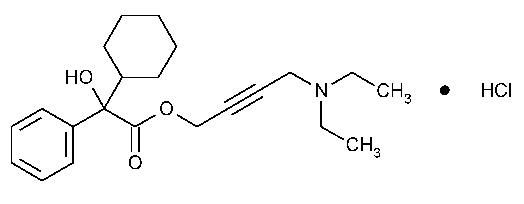Oxybutynin Chloride
Benzeneacetic acid,a-cyclohexyl-a-hydroxy-,4-(diethylamino)-2-butynyl ester hydrochloride,(±)-.
4-(Diethylamino)-2-butynyl (±)-a-phenylcyclohexaneglycolate hydrochloride [1508-65-2].
»Oxybutynin Chloride contains not less than 97.0percent and not more than 101.0percent of C22H31NO3·HCl,calculated on the dried basis.
Packaging and storage—
Preserve in well-closed containers.
USP Reference standards á11ñ—
USP Oxybutynin Chloride RS.USP Phenylcyclohexylglycolic Acid RS.
Identification,
Infrared Absorption á197Kñ.
Loss on drying á731ñ:
Dry it at 105 for two hours:it loses not more than 3%of its weight.
for two hours:it loses not more than 3%of its weight.
Residue on ignition á281ñ:
not more than 0.1%.
Heavy metals,Method Iá231ñ:
0.002%.
Chromatographic purity—
Triethanolamine phosphate solution—
Dissolve 2mLof triethanolamine in about 900mLof water in a 1000-mLvolumetric flask,adjust with phosphoric acid to a pHof 3.5,dilute with water to volume,and mix.
Mobile phase—
Prepare a degassed and filtered mixture of acetonitrile and Triethanolamine phosphate solution(65:35).Make adjustments if necessary (see System Suitabilityunder Chromatography á621ñ).
Standard preparation—
Prepare a solution containing 2.0mg of USP Oxybutynin Chloride RSper mLand 10µg of USP Phenylcyclohexylglycolic Acid RSper mLin acetonitrile.Filter through a 0.45-µm filter.
Test preparation—
Transfer 200mg of Oxybutynin Chloride,accurately weighed,to a 100-mLvolumetric flask,dissolve in acetonitrile,dilute with acetonitrile to volume,and mix.
Chromatographic system
(see Chromatography á621ñ)—The liquid chromatograph is equipped with a 200-nm detector and a 4.6-mm ×25-cm column that contains packing L7,and a short pre-column that contains packing L7is used if necessary.The column is maintained at a temperature of 45 .The flow rate is about 3mLper minute.Chromatograph a solution in acetonitrile containing 40µg per mLeach of USP Oxybutynin Chloride RSand USP Phenylcyclohexylglycolic Acid RS,and record the peak responses as directed for Procedure:the relative standard deviation of the responses for replicate injections is not more than 3.0%,and the resolution,R,of the main peaks is not less than 5.0.
.The flow rate is about 3mLper minute.Chromatograph a solution in acetonitrile containing 40µg per mLeach of USP Oxybutynin Chloride RSand USP Phenylcyclohexylglycolic Acid RS,and record the peak responses as directed for Procedure:the relative standard deviation of the responses for replicate injections is not more than 3.0%,and the resolution,R,of the main peaks is not less than 5.0.
Procedure—
Separately inject equal volumes (about 20µL)of the Standard preparationand the Test preparationinto the chromatograph,and record the chromatograms.The relative retention times are about 0.2for phenylcyclohexylglycolic acid and 1.0for oxybutynin.In the chromatogram of the Test preparation,any peak corresponding in retention time to phenylcyclohexylglycolic acid has a response not greater than that in the chromatogram of the Standard preparation,and the sum of the responses of all peaks,excluding the solvent front and oxybutynin,is not greater than twice that value.
Organic volatile impurities,Method Iá467ñ:
meets the requirements.
Chloride content—
Dissolve about 600mg of oxybutynin chloride,previously dried and accurately weighed,in 100mLof water,and add 5mLof nitric acid.Titrate (see Titrimetry á541ñ)with 0.1Nsilver nitrate VS,determining the endpoint potentiometrically,using a platinum-silver chloride electrode system.Each mLof 0.1Nsilver nitrate is equivalent to 3.545mg of Cl:the content is between 8%and 10%.
Assay—
Dissolve about 500mg of oxybutynin chloride,accurately weighed,in 50mLof glacial acetic acid,and add 10mLof mercuric acetate TS.Add five drops of crystal violet TS,and titrate (see Titrimetry á541ñ)with 0.1Nperchloric acid VSto an emerald-green endpoint.Perform a blank determination,and make any necessary correction.Each mLof 0.1Nperchloric acid is equivalent to 39.40mg of C22H31NO3·HCl.
Auxiliary Information—
Staff Liaison:Elena Gonikberg,Ph.D.,Scientist
Expert Committee:(PA4)Pharmaceutical Analysis 4
USP28–NF23Page 1435
Pharmacopeial Forum:Volume No.30(3)Page 908
Phone Number:1-301-816-8251
